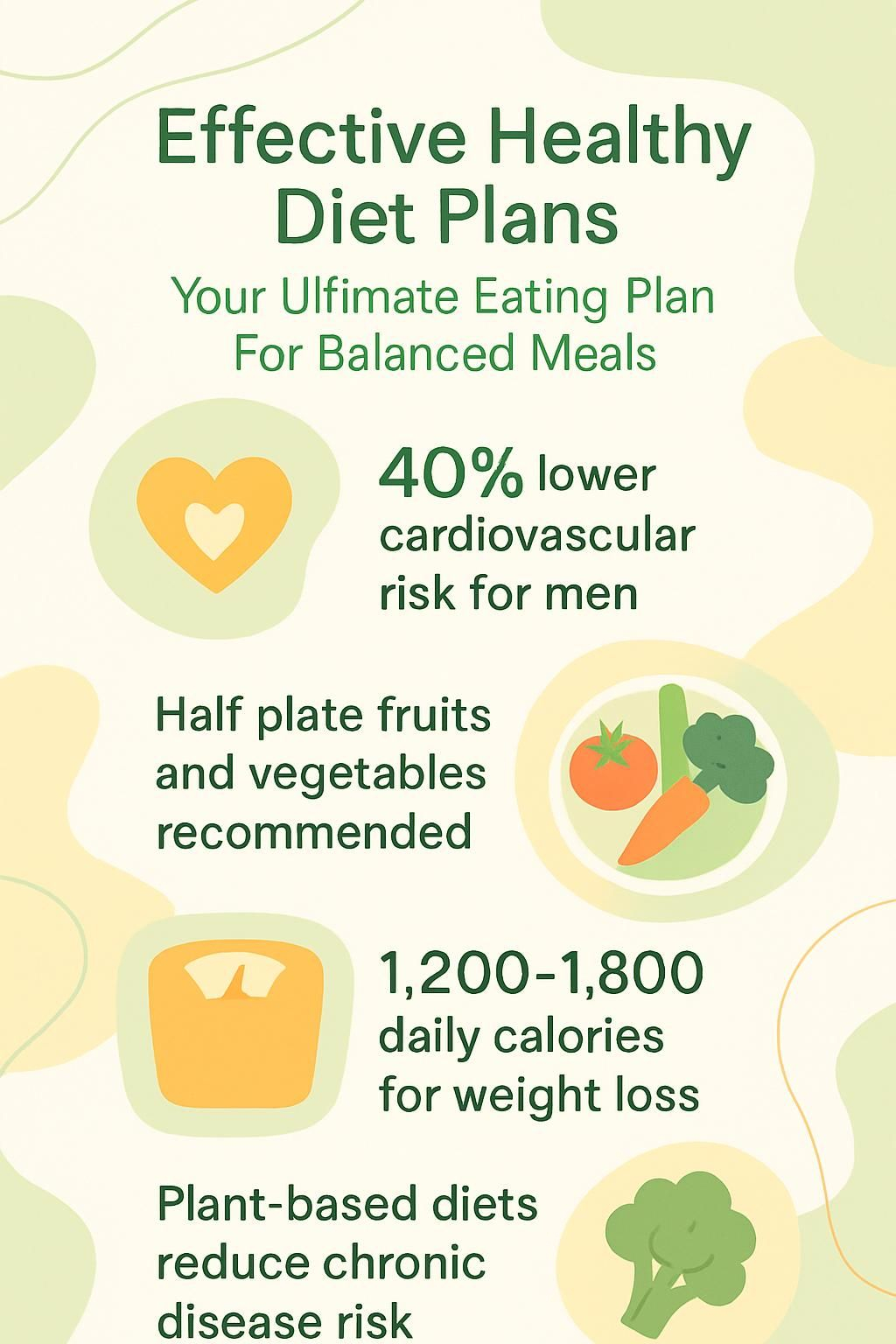Effective Healthy Diet Plans: Your Ultimate Eating Plan For Balanced Meals
Our Nutrition Assistant AI Suite will transform your body. You will lose fat, get toned, and build muscle. Gain confidence and optimal health.
If the advice on healthy eating feels confusing, you are not alone. A clear eating plan helps you get needed nutrients, control calories, and work toward a healthy weight. This guide shows you how to build a simple meal plan with balanced meals that can lower the risk of heart disease and other problems. Keep reading for practical steps you can use today for healthy eating.
Key Takeaways
- Healthy diet plans such as Mediterranean and DASH are linked with lower cardiovascular disease risk, up to 40% for men and 30% for women, based on American Heart Association summaries.
- Balanced meals fill half your plate with fruits and vegetables, add whole grains and lean protein, and limit added sugars, saturated fat, and sodium.
- For weight loss, common calorie targets are 1,200 to 1,500 per day for many women and 1,500 to 1,800 for men or active women. Cutting 500 to 750 calories per day often leads to 1 to 2 pounds lost per week.
- Plant-forward eating patterns and nutrient-dense foods support weight control and lower chronic disease risk in large studies, including Advances in Nutrition (2022).
- Hydration matters. Choosing water over sugary drinks supports digestion, steadier energy, healthier blood pressure, and fewer excess calories, consistent with Healthy Eating Plate guidance.

What Are Healthy Diet Plans and How Do They Work?

Healthy diet plans give your body the right mix of nutrients while helping you manage weight and reduce disease risk. A balanced diet uses all the major food groups, including vegetables, fruits, whole grains like brown rice or whole-wheat bread, lean proteins such as poultry and beans, dairy or dairy alternatives, and small amounts of healthy fats.
Tools like the MyPlate calculator estimate daily calorie needs based on age, sex, activity, and health goals. Many people lose weight safely by trimming 500 to 750 calories per day. Typical ranges are 1,200 to 1,500 calories for many women and 1,500 to 1,800 for men or active women. Very low calorie plans under 800 calories need medical supervision.
Healthy eating supports daily energy, and it can lower your risk for heart disease.
Most plans limit added sugar and saturated fat found in foods like sausage, butter, and high-fat desserts. They favor healthier fats such as olive oil and avocado. Choosing nutrient-dense foods, which give more nutrients per calorie, helps protect your heart according to the American Heart Association.
Essential Components of a Balanced Diet
A healthy diet includes a variety of foods so you get a broad range of nutrients. Knowing the building blocks makes it easier to assemble balanced meals for any meal plan.
Why Are Vegetables and Fruits Important for Health?
Vegetables and fruits provide vitamins, minerals, dietary fiber, and antioxidants. Many experts, including the United States Department of Agriculture, suggest filling half your plate with produce at each meal. This habit supports digestion, immunity, and heart health.
White potatoes and French fries do not count toward the vegetable goal because they are high in starch and often fried. Choose different colors and types each day. Variety helps supply vitamin C, potassium, folate, and plant compounds that lower the risk of chronic conditions such as heart disease and cancer.
As a guide, aim for about 50 percent vegetables or fruit on your plate at lunch and dinner. For example, a steak dinner where vegetables fill half the plate, steak covers one quarter, and a whole grain like pasta covers the other quarter, often totals around 700 calories. At breakfast, pair fruit with protein like eggs or yogurt plus whole grain cereal to steady blood sugar and support morning energy.
Higher intake of diverse fruits and vegetables is linked with a healthier body weight and better cholesterol in many studies.
What Are the Benefits of Whole Grains?
Whole grains such as brown rice, quinoa, barley, and whole wheat bread keep the grain’s bran and germ. These parts contain fiber, B vitamins, and minerals that are removed in refined grains like white bread or white rice. Whole grains digest more slowly, which supports steadier blood sugar.
Healthy Eating Plate and Food Pyramid resources suggest that most grain servings should be whole. Choosing whole grains over refined grains is linked with a lower risk of heart disease. For instance, a burrito with grilled chicken, vegetables, beans, and a whole wheat tortilla can stay under 750 calories. Skipping the rice can reduce it to under 500 calories, depending on serving size.
Smaller portions help control calorie intake, a point supported by research summarized in Advances in Nutrition (2022). Pick quality carbohydrates from whole grains, and limit sugary drinks and sweets for steadier energy across the day.
How Do Lean Proteins Support Your Body?
Lean protein builds and repairs muscle tissue. Good choices include fish, skinless poultry, beans, eggs, nuts, and lean cuts of beef. These foods supply amino acids, which are the building blocks of protein, without too much saturated fat.
Heart-healthy patterns favor seafood and plant-based sources like soy. Studies show that following Healthy Eating Pyramid guidance is associated with lower cardiovascular disease risk, near 40% in men and 30% in women in some cohorts. Aiming for about one quarter of your plate from protein at each meal supports fullness and weight management.
Limiting red and processed meats, such as bacon and deli meats, can reduce risk factors tied to heart disease and high blood pressure. Many people feel steadier energy during the day after swapping processed meats for grilled or baked options.
Why Are Healthy Fats Necessary?
Your body needs healthy fats to absorb vitamins, build cell membranes, and support brain function. Oils like olive and canola provide unsaturated fats that can lower the risk of atherosclerosis and heart attack.
Healthy Eating Plate guidance suggests using these oils instead of butter or foods high in trans fat. Diet quality indexes, such as the Alternate Healthy Eating Index, score higher when the fat sources are mostly unsaturated. Use vegetable oils for cooking in place of cream, sour cream, or full-fat dairy.
Choose guacamole or a small handful of nuts instead of sauces loaded with saturated fat. I switched to extra virgin olive oil on salads rather than heavy dressings, and my cholesterol improved over several months. Avoid trans fat listed on food labels during grocery shopping to protect your heart.
What Are Good Dairy or Dairy Alternatives for Nutrition?
Pick fat-free or low-fat dairy, such as skim milk, low-fat yogurt, or reduced-fat cheese. The Healthy Eating Plate recommends one to two servings per day to meet needs without too many calories.
Choose nutrient-dense options like plain Greek yogurt instead of products high in sugar and salt. If you avoid cow’s milk due to lactose intolerance or a plant-based diet, try calcium-fortified soy milk or almond milk. These drinks can provide key nutrients without the saturated fat found in full-fat dairy.
Limit full-fat varieties because too much saturated fat can raise blood pressure and heart disease risk. Read labels to compare oils and added sugars in non-dairy milks. Some options include omega-3 fatty acids for extra health benefits.
I switched from whole milk to oat milk in my cereal. It tastes good and keeps my morning calories lower. Choose unsweetened versions to avoid added sugars. Your needs may vary by age, activity, and health goals. Plans like the Mediterranean Diet and Food Pyramid offer helpful guidance.
How Does Staying Hydrated Impact Your Health?
Water helps keep body temperature stable, moves nutrients to cells, and removes waste. The Healthy Eating Plate suggests water, tea, or coffee with little or no sugar. Sugary drinks add calories and are linked with higher heart disease risk.
Hydration supports physical activity since muscles work better when fluid needs are met. It also aids weight control because thirst can feel like hunger. Many people do well with water instead of sports drinks or sodas that add sugar and sodium. There is no single fluid target for all people. Choose healthy beverages that fit your needs and culture.
What Are the Benefits of Following Healthy Diet Plans?
Healthy diet plans offer many benefits that you can feel day to day. Small, steady changes add up to better health over time.
How Does a Healthy Diet Boost Physical Health?
Eating from all food groups supports muscles, bones, and organs. Balanced meals with vegetables, fruits, whole grains, lean protein, and healthy fats strengthen the immune system and heart.
Choosing unsalted nuts and low-fat dairy helps protect the heart. Combined with regular physical activity, balanced diet plans can help you reach a healthy weight range. Portion sizes matter for energy balance. Targeting about 750 calories for a large meal can support goals without feeling deprived.
Pick water over sugary drinks to stay hydrated without extra calories. Simple swaps such as a side salad or dried fruit in place of candy add nutrients and keep meals interesting.
In What Ways Can Diet Improve Mental Well-being?
Regular, balanced meals help keep blood sugar steady, which can reduce anxiety and irritability. Drinking water supports attention and memory. A mix of vegetables, fruits, whole grains, and lean proteins gives your brain the antioxidants and nutrients it needs.
Sugary drinks can lead to quick spikes and crashes that affect mood. Cutting back on ultra-processed foods and unhealthy fats supports clearer thinking. Setting small, specific eating goals can build motivation and confidence over time.
During a stressful work month, I prepared a simple vegetable soup on Sundays. Having it ready helped me focus better in the afternoons compared with grabbing sweet snacks.
How Does a Healthy Diet Help with Weight Management?
Tracking intake and measuring portions helps set a calorie baseline. Staying within your calorie target supports steady progress. Many women aiming for weight loss do well at 1,200 to 1,500 calories per day. Men and very active women may need 1,500 to 1,800.
Reducing daily calories by 500 to 750 often results in losing one to two pounds per week. Pick lean cuts of meat, and favor grilling over frying to limit unhealthy fats. The Healthy Eating Plate offers a clear model, with half the plate vegetables and fruits, a quarter lean protein, and a quarter whole grains.
Swapping a high-calorie restaurant steak meal, often up to 1,500 calories, for a home steak dinner with plenty of vegetables can total around 700 calories. These strategies support weight control and overall wellness.
Next, see how healthy eating can reduce the risk of chronic diseases such as diabetes and heart disease.
Can Healthy Eating Lower the Risk of Chronic Diseases?
Healthy eating patterns can lower the risk of heart disease, type 2 diabetes, and early death. People who score high on the Alternate Healthy Eating Index show lower all-cause mortality and fewer heart disease deaths in large cohorts.
Lean proteins, more fruits and vegetables, whole grains, and water instead of sugary drinks help reduce chronic disease risk. At home, moving from processed foods to meals centered on fresh produce and whole grains can improve cholesterol within months. Limiting red meat, unhealthy fats, and added sugars strengthens these gains.
How Does a Balanced Diet Elevate Energy Levels?
Balanced meals help maintain steady blood sugar and a stable mood. Whole grains, fruits, and lean proteins supply lasting fuel. A 400 calorie breakfast that includes fruit, protein, and a whole grain can power your morning for hours.
Water intake also supports alertness since dehydration often causes fatigue. Limiting sugary drinks and refined grains reduces energy crashes at school or work. Variety matters because your cells need many nutrients to make energy from carbohydrates and fat.
Overeating can lead to sluggishness. Portion control helps you feel satisfied but light. After shifting from high-sugar snacks to nutrient-dense foods like brown rice or chicken, many people notice fewer afternoon slumps.
Popular Healthy Diet Plans and Their Benefits
Several well-researched eating styles can fit your goals. Each plan has clear steps that support heart health, blood pressure, and weight management.
How Does the Mediterranean Diet Promote Heart Health?
The Mediterranean diet emphasizes vegetables, fruits, whole grains, beans, nuts, and healthy oils, with moderate fish and poultry. It limits red and processed meats and avoids unhealthy fats. Olive oil is a central fat source and aligns with Healthy Eating Plate advice.
Large studies link this pattern with lower cardiovascular disease risk, nearly 40% for men and about 30% for women in some analyses. People who adopt this style often see healthier cholesterol over time.
I swapped butter for extra virgin olive oil and increased vegetables and grilled fish. After several weeks, I felt lighter and more energized.
What Are the Key Features of the DASH Diet for Blood Pressure?
The DASH diet focuses on fruits, vegetables, whole grains, and low-fat dairy. It also emphasizes limiting sodium. The American Diabetes Association supports DASH for broader health benefits.
Clinical research shows that lowering sodium helps reduce blood pressure. DASH suggests staying under 2,300 milligrams per day and striving for 1,500 milligrams for more benefit. Choose lean proteins like chicken or fish. Cut back on processed foods that often contain high saturated fat and added sugars.
Portion control and hydration support DASH goals. Many people see better blood pressure numbers by following these steps along with regular physical activity.
What Are the Advantages of Plant-Based Diets?
Plant-based diets center on vegetables, fruits, whole grains, beans, and nuts. These foods offer fiber, vitamins, and minerals while limiting red and processed meats. The Healthy Eating Plate also encourages plant-based proteins for heart health.
Evidence links plant-focused eating with lower risks of type 2 diabetes and heart disease. These diets can also reduce environmental impact. Many people find it easier to choose water over sugary drinks in this pattern, which further supports wellness.
How Do Low-Carb Diets Aid in Weight Loss?
Low-carb plans reduce refined grains and added sugars. They emphasize nutrient-dense foods like whole grains, vegetables, fruits, and lean proteins while keeping total carbs in check. The goal is better blood sugar control and improved fullness.
Research shows that adults on low-carb diets often experience short-term weight loss due to fewer calories and greater satiety. The Healthy Eating Plate still applies because quality carbohydrates matter as much as quantity.
Portion control remains important. Many people report fewer cravings and steadier energy when they limit refined carbs. Balanced meals with lean protein, plenty of nonstarchy vegetables, and modest whole grains support fat loss and protect muscle.
How Can Intermittent Fasting Be Integrated Into Your Diet?
Intermittent fasting limits eating to a set window. One common version is the 16:8 method, with 16 hours of fasting and an 8 hour eating window. Many people start eating at noon and finish by 8 p.m.
During eating hours, follow Healthy Eating Plate guidance, including vegetables, fruits, whole grains, lean proteins, and healthy fats. Plan meals ahead so you do not overeat when you break your fast. Use an app or journal to track portions and progress. Hydrate with water during fasting hours to curb hunger.
I began with a 14:10 schedule and used meal tracking. The structure made it easier to follow my goals without feeling restricted. If you have a medical condition or take medicines like insulin, talk with your healthcare provider before starting.
After seeing how fasting can fit different lifestyles, you may want to build a personal healthy eating plan that suits your needs.
How to Create Your Personal Healthy Eating Plan
A personal plan turns good intentions into daily habits. The steps below help you match food choices to your goals.
How to Calculate Your Calorie Requirements?
You need a daily calorie target to guide your meal plan. A realistic number supports your energy and health goals.
- Use a calorie tool such as the MyPlate Plan Calculator for an estimate based on age, sex, size, and activity level.
- Track everything you eat and drink for several days to find your baseline intake. An app or food diary improves accuracy.
- Reduce daily intake by 500 to 750 calories to aim for losing one to two pounds per week, a pace supported by major health groups.
- Use general ranges as a starting point. Many women do well with 1,200 to 1,500 calories per day. Men and active women often need 1,500 to 1,800.
- Avoid plans under 800 calories unless supervised by a medical professional.
- Adjust targets if your weight changes too fast or too slowly. Recheck after shifts in activity or health status.
- Measure portions with a scale or measuring cups to prevent underestimating intake.
- Personalize for special needs such as diabetes, pregnancy, or training schedules, since these needs differ.
Knowing your calorie needs makes it easier to focus on nutrient-dense foods in a balanced diet.
Why Focus on Nutrient-Dense Foods?
Nutrient-dense foods pack more vitamins, minerals, and fiber into each bite. Examples include whole grains, colorful vegetables, fruits, and plant-based proteins. These choices fuel your body without excess calories or additives.
Healthy Eating Plate guidance recommends variety. Swapping white rice for brown rice increases B vitamins and fiber. Choosing fat-free or low-fat dairy instead of full-fat options cuts saturated fat while keeping protein and calcium.
Limiting processed grains, added sugars, and unhealthy fats helps you get more value from every calorie. Many people find that whole grain pasta, compared with regular pasta, promotes fullness and more stable energy.
How to Reduce Saturated Fats, Sugars, and Sodium?
Lowering saturated fat, added sugar, and sodium supports heart health and blood pressure. Small changes make a big difference over time.
- Cook with olive or canola oil instead of butter to reduce saturated fat.
- Choose fat-free or low-fat dairy, and keep milk or dairy to 1 to 2 servings per day.
- Limit red and processed meat. Pick lean proteins like fish, beans, or skinless chicken.
- Cut back on processed foods and packaged snacks that often contain added sugars and sodium.
- Use herbs and spices instead of salt to season dishes, a core DASH strategy.
- Favor whole fruits over fruit juice, and avoid sugary drinks.
- Read labels for trans fat, sodium, and added sugars. Pick the lowest numbers.
- Avoid partially hydrogenated oils, a source of trans fat linked with heart disease.
- Cook more at home to control fat, sugar, and salt.
- Snack on unsalted nuts or fresh vegetables instead of chips or sweet baked goods.
- Gradually reduce the salt and sugar you add at the table so your taste adjusts.
What Are Strategies for Balanced Meals and Snacks?
Balanced meals and snacks keep energy steady and hunger in check. Use these steps to build better plates at home and away.
- Fill half your plate with vegetables and fruits, as the MyPlate Plan suggests, to boost fiber and micronutrients.
- Split the other half between lean protein and whole grains to balance carbohydrates and amino acids.
- Cook with healthy oils, and avoid trans fats found in many packaged snacks.
- Build a breakfast near 400 calories using fruit, protein such as eggs or Greek yogurt, and whole grain toast.
- Pick nutrient-dense snacks like nuts, plain yogurt, or fresh fruit, not processed options high in added sugars.
- Watch portions. A dinner with 25 percent steak, 25 percent whole grain starch, and 50 percent vegetables often lands near 700 calories.
- Drink water across the day to support digestion, thinking, and activity.
- Limit high-sodium processed foods. Try air-popped popcorn or sliced veggies instead of salty chips.
- Add variety each week by rotating produce, proteins, dairy alternatives, and whole grains to avoid boredom and cover more nutrients.
Prepping small snack packs such as carrot sticks or berries can make healthy choices easier after work or school.
How to Add Variety to Your Diet?
Variety helps you meet nutrient needs and keeps meals interesting. It also reduces the chance of gaps in your diet.
- Choose different fruits and vegetables daily, aiming for many colors. The Healthy Eating Plate suggests excluding white potatoes and fries due to lower nutrient value.
- Pick whole grains such as brown rice, quinoa, or whole wheat bread for more fiber.
- Use plant-based proteins like beans, lentils, tofu, or nuts to expand your options.
- Rotate lean proteins such as chicken, fish, eggs, or turkey during the week.
- Explore international cuisines to discover new flavors while meeting nutrition goals.
- Cook with seasonal produce for freshness and often better prices.
- Include dairy or fortified plant-based options like soy milk with low sugar for calcium and vitamin D.
- Serve different foods at each meal instead of repeating the same menu.
- Replace less healthy snacks with fruit slices, yogurt, or trail mix with unsalted nuts.
- Drink water regularly instead of sugary beverages to support digestion and hydration.
How Can You Maintain a Healthy Diet Plan Long-Term?
Long-term success comes from systems, not willpower alone. Build habits that make balanced meals your default choice.
Why Is Planning Meals in Advance Important?
Planning ahead helps you hit calorie and nutrient targets. A weekly plan improves portion control and reduces reliance on fast food.
Meal prepping makes busy days easier and lowers stress. It also cuts the chance of skipping meals or overeating. Planning recipes before shopping prevents impulse buys. During a heavy work season, prepping three lunches at a time helped me stay on track and avoid takeout.
What Are Smart Grocery Shopping Tips?
Good shopping habits make healthy cooking faster and more affordable. A list and a plan remove guesswork at the grocery store.
- Make a list with vegetables, fruits, whole grains, and lean proteins. Stick to it to avoid impulse buys.
- Shop the store perimeter for fresh produce, meats, dairy, and bakery items where many nutrient-dense foods are found.
- Choose less processed items with fewer additives, lower sodium, and higher nutritional value.
- Read labels for serving size, calories, saturated fat, sodium, and added sugars.
- Limit foods high in saturated fat, sodium, or sugar. Many adults should keep sodium under 2,300 milligrams per day.
- Pick low-fat or fat-free dairy for calcium with less saturated fat.
- Buy healthy oils like olive or canola instead of butter or lard.
- Include plant-based proteins like beans or tofu for variety.
- Favor seasonal produce for better flavor and often lower cost.
- Avoid shopping while hungry to reduce the pull of high-calorie snacks.
How to Make Healthy Choices When Eating Out?
Eating out can fit your plan with a few smart moves. Small changes to ordering can cut calories and add nutrients.
- Check the menu ahead of time to find balanced choices and possible swaps.
- Ask for extra vegetables instead of fries or white rice.
- Choose grilled, baked, or steamed proteins instead of fried options.
- Get sauces and dressings on the side to control added fats and sugars.
- Drink water or unsweetened tea to avoid liquid calories.
- Share large entrees or box half to take home.
- Watch portions. A steakhouse meal can reach 1,500 calories without adjustments.
- Build a lighter version of favorites. A burrito with grilled chicken, a whole wheat tortilla, and fresh veggies can land under 750 calories, or under 500 without rice.
- Pick a breakfast with fruit, protein, and whole grains near 400 calories instead of diner meals that can top 700 calories.
- Skip bread baskets and heavy appetizers to prevent extra calories before the main dish.
- Request substitutions. Add vegetables and reduce large starch sides for a better balance.
How to Manage Cravings and Emotional Eating?
Cravings and stress eating are common. A plan helps you steer through tough moments without losing progress.
- Set clear, realistic goals to keep your focus.
- Eat balanced meals and snacks on a schedule to avoid extreme hunger.
- Choose nutrient-dense snacks like fruit, nuts, or yogurt.
- Identify triggers and pick a different action, such as a short walk or a phone call.
- Keep tempting high-fat, high-sugar snacks out of the house.
- Practice mindful eating so you can tell hunger from emotion.
- Track your intake to spot patterns and triggers.
- Ask friends, family, or a health professional for support if you need it.
How to Adjust Diet Plans for Special Dietary Needs
Some people need specific adjustments due to health conditions or personal choices. With planning, you can meet your needs and keep meals enjoyable.
What Should You Know About Vegetarian or Vegan Diets?
Vegetarian diets avoid meat. Vegan diets avoid all animal products. Both center on vegetables, fruits, whole grains, beans, nuts, and seeds. The Healthy Eating Plate still applies, with half your plate from vegetables and fruits.
Plan for protein, iron, calcium, vitamin B12, and omega-3 fats. Use fortified foods or supplements when needed, especially for B12 in strict vegan plans. A varied plant-based eating plan can support heart health and weight control.
What Are Gluten-Free Living Options?
Gluten-free eating removes wheat, barley, and rye. Safe options include rice, corn, quinoa, and potatoes. Many stores carry gluten-free bread, crackers, cereals, and pasta. Reading labels helps you avoid hidden gluten in processed items.
Home cooking offers better control. Try salads with fresh greens plus grilled chicken or fish for a balanced meal. When dining out, choose simple dishes like plain proteins and steamed vegetables. Fruits and nuts make easy gluten-free snacks.
How Can Diet Help Manage Diabetes?
A steady eating plan supports blood sugar control. Include vegetables, fruits, whole grains, and lean proteins at each meal. The Healthy Eating Plate method, with half the plate produce, helps with portions.
Cook with olive or canola oil, and avoid saturated and trans fats to protect your heart. Limit added sugars and refined grains to prevent spikes. Swapping white bread for whole grain options can reduce swings in blood glucose.
Meal planning and tracking make it easier to meet calorie goals and enjoy variety each week. Many people with diabetes report steadier energy and mood when they plan ahead. Speak with a registered dietitian or clinician for a plan that fits your medications and lab targets.
How to Choose Heart-Healthy Foods?
Fill half your plate with colorful vegetables and fruits. Choose whole grains like brown rice or whole wheat bread to help lower cholesterol and stabilize blood sugar. Swap full-fat dairy for fat-free or low-fat options to reduce saturated fat.
Pick lean proteins such as fish, chicken breast, beans, or tofu. Follow Healthy Eating Plate guidance, and keep sodium under 2,300 milligrams per day, based on recent American Heart Association advice. These swaps support long-term heart health.
Next are tools that can help you follow your plan and track progress.
What Resources Can Support Your Diet Plan?
Helpful tools make planning simpler. Use calculators and apps to personalize goals, plan meals, and monitor intake.
How to Use the MyPlate Plan Calculator?
Visit the MyPlate Plan Calculator. Enter your age, sex, height, weight, and activity level. The tool estimates daily calories and suggests amounts for each food group.
Use the results to build your shopping list and meals. If your plan calls for two cups of fruit per day, choose different fruits across the week for variety. Follow the guidance to meet nutrition targets without guesswork.
What Are the Best Apps for Meal Planning?
Apps such as Mealime, Yummly, and Paprika help you build weekly menus and shopping lists. Mealime tailors menus to your needs. Yummly filters recipes for allergies and preferences. Paprika stores recipes and organizes lists.
Planning with an app can save time and reduce food waste. Many apps also show nutrition information and let you scan barcodes to log packaged foods quickly. Simple interfaces make meal planning easier for busy schedules.
How to Track Food Intake Effectively?
Write down everything you eat and drink each day. Use a notebook or a digital tracker to estimate calories and nutrients. A clear record helps you set a baseline and adjust goals.
Many adults lose weight by reducing daily calories by 500 to 750, often leading to 1 to 2 pounds lost per week. Watch portion sizes because they directly affect total calories. Your age and activity level shape your needs. Reliable nutrition information is available at resources such as www.mypyramid.gov.
Food logs help people spot patterns and make better choices over time. Next, check common planning errors so you can avoid setbacks.
What Common Errors Should You Avoid in Diet Planning?
Simple mistakes can stall progress. Knowing them helps you stay consistent and get results from your eating plan.
Why Should You Avoid Skipping Meals?
Skipping meals can reduce your nutrient intake and drain your energy. It can also lead to overeating later in the day. Many people who skip breakfast end up snacking on less healthy foods and find it hard to focus.
Missing meals can slow your metabolism and cause blood sugar swings. This makes weight goals harder to reach. Planning balanced snacks can keep energy steady and prevent overeating, even with healthy foods.
Can You Overeat Healthy Foods?
It is possible to overeat healthy foods if portions are large. Nuts, avocados, and whole grains are nutrient-rich but calorie-dense. Eating several servings can add many calories without noticing.
People often confuse serving size with portion size. For example, one ounce of almonds is about 23 nuts. Three servings as a snack adds roughly 300 calories. Measuring food and reading labels helps you stay within your plan.
Paying attention to servings supports your goals for both health and weight management. Many clinical resources, including Harvard Health Publishing and Mayo Clinic briefs, stress this point.
How to Watch Your Portion Sizes?
Serving size is the standard amount listed on labels. Portion size is what you actually eat. Aim to fill half your plate with vegetables and fruits, one quarter with lean protein, and one quarter with whole grains.
Measure food with cups, spoons, a scale, or use hand estimates if tools are not available. Track what goes on your plate with an app or journal. This habit supports calorie control and balanced nutrition.
Intentional meal planning gives you more control during busy days. Next, explore strategies for keeping a healthy diet plan long-term so your new habits stick.
Conclusion
Effective healthy diet plans focus on vegetables, fruits, whole grains, lean proteins, and healthy fats. This balanced diet supports physical health, mental focus, and a healthy weight. Using a simple eating plan helps you manage calories while meeting your body’s needs.
Set a realistic meal plan, track progress, and make small adjustments as needed. Healthy eating gets easier once it becomes part of your routine. If you have a medical condition, talk with a healthcare provider for personalized advice. Start with one change this week, such as adding a side salad or swapping soda for water, and build from there.
FAQs
1. What makes a diet plan effective for balanced meals?
An effective healthy eating plan includes a variety of foods from all food groups, such as grains, lean proteins, fruits, vegetables, and dairy products. Research shows that balanced diets help maintain steady energy levels and support long-term health outcomes (Harvard T.H. Chan School of Public Health).
2. How can I create an ultimate eating plan that fits my lifestyle?
Start by assessing your daily routine and nutritional needs. Choose whole foods with high nutrient density like brown rice instead of white bread or salmon instead of processed meats. A registered nutritionist can help tailor meal plans to fit individual goals.
3. Are there any statistics on the benefits of following healthy diet plans?
Yes; studies show people who follow balanced meal patterns have lower risks for heart disease and type 2 diabetes (Centers for Disease Control and Prevention). For example:
– People who eat at least five servings of produce each day reduce their risk for chronic illness by up to 20 percent.
– Diets rich in fiber improve digestive health in over 70 percent of adults surveyed.
4. Can you share a personal experience about starting a new eating plan?
After switching to more plant-based meals last year, I noticed improved focus during work hours and fewer afternoon energy crashes compared to when I ate mostly fast food lunches. This change made it easier to stick with my exercise routine too.
Summary: Effective healthy diet plans rely on diverse food choices tailored to individual needs; evidence supports their role in reducing disease risk while improving daily well-being through better nutrition habits.







